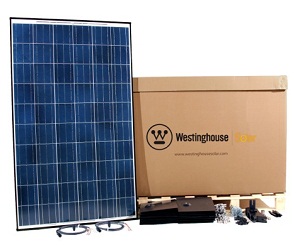Inverter- and rack-integrated solar module turns heads at PV America
 Westinghouse Solar, Inc. (Nasdaq:WEST) introduced the second generation of its AC-integrated photovoltaic modules at PV America in Philadelphia this week. The 235-watt modules differ from most other photovoltaic modules available on the market. They’re built with a micro-inverter and racking and mounting equipment integrated.
Westinghouse Solar, Inc. (Nasdaq:WEST) introduced the second generation of its AC-integrated photovoltaic modules at PV America in Philadelphia this week. The 235-watt modules differ from most other photovoltaic modules available on the market. They’re built with a micro-inverter and racking and mounting equipment integrated.
When the company introduced its first AC-integrated crystalline silicon solar module in 2009, it won the 2009 Popular Mechanics Breakthrough Award. This second generation module, which will be available in the second quarter of 2011, builds on that success.
“We realized that installing ordinary solar power systems was cumbersome and not terribly efficient for installers who needed to design a system rapidly and get on and off the roof quickly,” said Gary Mull, vice president of marketing at Westinghouse Solar. “What we were able to do through the integration was reduce the number of components [of a photovoltaic system] by 80 percent.”
Since everything is integrated into the panel, it also can halve installation time.
The second generation of the integrated module has updated features and components allowing it to be lighter and further reduce the need for additional equipment, according to Mull. With the inclusion of a micro-inverter, the AC current is produced at the module, reducing the danger of dealing with 600 volt DC power, Mull said.
The micro-inverters can also communicate production data back to the array owners and the installers.
“They’re wired in parallel so if one panel degrades, the whole string doesn’t degrade,” Mull said.
If there is a problem with a panel, the solar installer can be altered to it so they can come out and fix it.
The combination of technologies creates a module that offers 5 percent to 25 percent greater performance than from a regular DC module, according to Mull.
Earlier Westinghouse Solar modules cost more than most other photovoltaic panels, according to Mull. The additional components add cost, including the cost of the micro-inverters, which retail for about $200 each.
“Through improvements, we are now priced competitive, with the most price efficient panels in the industry today,” he said.
Mull would not offer production capacity figures for the modules.
“We have production scale up capabilities that allow us to produce to a variety of scenarios,” he said. “We are contract manufacturing. Capacity is not an issue here.”



